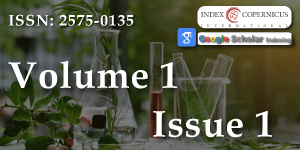Impact of Calcium Phosphate Nanoparticles on Rice Plant
Main Article Content
Abstract
Calcium phosphates are of great interest in medicine, biology, agriculture and materials sciences. The present study evaluates the effect of calcium phosphates nanoparticles on biochemical changes in rice. Nanoparticles increased the growth rate and affect the physiology of the plant. Calcium phosphate nanoparticles may help in the formulation of new nano growth promoter and nano-fertilizers for agricultural use. Therefore, it could potentially help in reduction of the quantity of fertilizer applied to crops and contributing to precision farming as it reduces fertilizer wastage and in turn environmental pollution due to agricultural malpractices. However, detail physiological and molecular understanding of its impact on rice crop plant is needed in future to validate its prospective application in agriculture.
Article Details
Copyright (c) 2017 Upadhyaya H, et al.

This work is licensed under a Creative Commons Attribution 4.0 International License.
Siddiqui MH, Al-Whaibi MH. Role of nano-SiO2 in germination of tomato (Lycopersicum esculentum seeds Mill.). Saudi J Biol Sci. 2014; 21: 13-17. Ref.: https://goo.gl/XDAqGr
Jampílek J, Kráľová K. Application of nanotechnology in agriculture and food industry, its prospects and risks. Ecological Chemistry and Engineering Sci. 2015; 22: 321-361. Ref.: https://goo.gl/RlnGP0
Giraldo JP, Landry MP, Faltermeier SM, McNicholas TP, Iverson NM, et al. Plant nanobionics approach to augment photosynthesis and biochemical sensing. Nature materials. 2014; 13: 400-408. Ref.: https://goo.gl/9Y7ois
Mahajan S, Pandey GK, Tuteja N. Calcium-and salt-stress signaling in plants: shedding light on SOS pathway. Arch Biochem Biophys. 2008; 471: 146-158. Ref.: https://goo.gl/McGh5Z
Lutts S, Kinet JM, Bouharmont J. Effects of salt stress on growth, mineral nutrition and proline accumulation in relation to osmotic adjustment in rice (Oryza sativa L.) cultivars differing in salinity resistance”. Plant Growth Regulation. 1996; 19: 207-218. Ref.: https://goo.gl/jPVuph
Knight H. Calcium signaling during abiotic stress in plants. Int Rev Cytol. 1999; 195: 269-324. Ref.: https://goo.gl/uekn95
Asano T, Hayashi N, Kobayashi M, Aoki N, Miyao A et al. A rice calcium‐dependent protein kinase OsCPK12 oppositely modulates salt‐stress tolerance and blast disease resistance. Plant J. 2012. 69: 26-36. Ref.: https://goo.gl/fSrGNV
Pandey S, Zhang W, Assmann SM. Roles of ion channels and transporters in guard cell signal transduction. FEBS Lett. 2007; 581: 2325-2336. Ref.: https://goo.gl/1rabbB
Das R, Pandey GK. Expressional Analysis and Role of Calcium Regulated Kinases in Abiotic Stress Signaling. Curr Genomics. 2014; 11: 2-13. Ref.: https://goo.gl/zDMq0l
Sanders D, Pelloux J, Brownlee C, Harper JF. Calcium at the crossroads of signaling. Plant Cell. 2002; 14: S401-S417. Ref.: https://goo.gl/JSjWRv
Trewavas AJ, Malhó R. Ca2+ signaling in plant cells: the big network. Curr Opin Plant Biol. 1998; 1: 428-433. Ref.: https://goo.gl/YZnYQ0
McAinsh MR, Gray JE, Hetherington AM, Leckie CP, Ng C. Ca2+ signalling in stomatal guard cells. Biochem Soc Trans. 2000; 28: 476-481. Ref.: https://goo.gl/cjGBrI
Luan S, Kudla J, Rodriguez-Concepcion M, Yalovsky S, Gruissem W. Calmodulins and calcineurin B-like proteins: calcium sensors for specific signal response coupling in plants. Plant Cell.2002; 14: S389-S400. Ref.: https://goo.gl/QwNHa1
Snedden WA, Fromm H. Calmodulin as a versatile calcium signal transducer in plants. New Phytologist. 2001; 151: 35-66. Ref.: https://goo.gl/lrsOUx
Zheng L, Hong F, Lu S, Liu C. Effect of nano-TiO2 on strength of naturally aged seeds and growth of spinach. Biol Trace Elem Res. 2005; 106: 279-297. Ref.: https://goo.gl/2hkbv6
Galbraith DW. Nanobiotechnology: silica breaks through in plants. Nat Nanotechnol. 2007; 2: 272-273. Ref.: https://goo.gl/nTbR5o
Mahajan P, Dhoke SK, Khanna AS. Effect of Nano-ZnO Particle Suspension on Growth of Mung (Vigna radiata) and Gram(Cicer arietinum) Seedlings Using Plant Agar Method. Journal of Nanotechnology. 2011; 2011: 1- 7. Ref.: https://goo.gl/gCskOk
Boonyanitipong P, Kositsup B, Kumar P, Baruah S, Dutta J. Toxicity of ZnO and TiO2 Nanoparticles on Germinating Rice Seed Oryza sativa L. International Journal of Bioscience, Biochemistry Bioinformatics. 2011; 1: 282-285. Ref.: https://goo.gl/BNxhy2
Liu R, Zhang H, Lal R. Effects of Stabilized Nanoparticles of Copper, Zinc, Manganese, and Iron Oxides in Low Concentrations on Lettuce (Lactuca sativa) Seed Germination: Nanotoxicants or Nanonutrients? Water, Air, and Soil Pollution. 2016; 227: 1-14. Ref.: https://goo.gl/0LWVpR
Rane M, Bawskar M, Rathod D, Nagaonkar D, Rai M. Influence of calcium phosphate nanoparticles, Piriformospora indica and Glomus mosseae on growth of Zea mays. Advances in Natural Sciences: Nanoscience and Nanotechnology. 2015; 6: 045014. Ref.: https://goo.gl/X8XyRI
Doke N. Involvement of superoxide anion generation in the hypersensitive response of potato tuber tissues to infection with an incompatable race of Phytophthora infestans and to the hyphal wall components. Physiological Plant Pathology. 1983; 23: 345-357. Ref.: https://goo.gl/cylbDi
Lin CC, Kao CH. Cell wall peroxidase activity, hydrogen peroxide level and NaCl-inhibited root growth of rice seedlings. Plant and Soil. 2001; 230: 135-143. Ref.: https://goo.gl/R1Qa1g
Zhang XZ. The measurement and mechanism of lipid peroxidation and SOD, POD and CAT activities in biological system. In Research Methodology of Crop physiology; Zhang, X.Z., Ed.; Agricultural Press: Beijing, China. 1992; 208-254.
Griffith OW. Determination of glutathione and glutathione disulfide using glutathione reductase and 2-vinylpyridine. Anal Biochem. 1980; 106: 207-212. Ref.: https://goo.gl/mhMJT6
Oser BL. Hawks physiological chemistry. McGraw Hill, NY, USA. 1979; 702-705.
Abei H. Catalse in vitro. Methods Enzymol. 1984; 105: 121-126. Ref.: https://goo.gl/EK2zJg
Chance B, Maehly AC. Assay of catalase and peroxidises. Methods Enzymology. 1955; 2: 764-775. Ref.: https://goo.gl/noFgcH
Giannopolitis CN, Ries SK. Superoxide dismutase I. Occurrence in higher plants. Plant Physiol. 1997; 59: 309-314. Ref.: https://goo.gl/fVDTTx
Smith IK, Vierheller TL, Thorne CA. Assay of glutathione reductase in crude tissue homogenates using 5, 51-dithiobis(2-nitrobenzoic acid). Anal Biochem. 1988; 175: 408-413. Ref.: https://goo.gl/EumbPn
Upadhyaya H, Dutta BK, Panda SK. Zinc modulates drought induced biochemical damages in tea [Camellia sinensis (L) O Kuntze]. J Agric Food Chem. 2013; 61: 6660-6670. Ref.: https://goo.gl/979vsz

